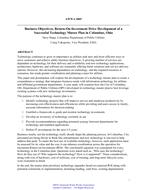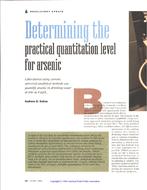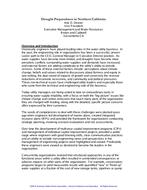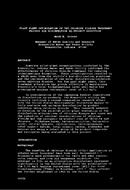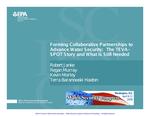Provide PDF Format
AWWA ACE61882
- Business Objectives, Return-On-Investment Drive Development of a Successful Technology Master Plan in Columbus, Ohio
- Conference Proceeding by American Water Works Association, 06/17/2005
- Publisher: AWWA
$12.00$24.00
This paper explores the development of a technology master plan to create acomprehensive strategy that integrates business needs with information technology for utilitiesand affiliated government departments. It presents a case study that examines how the City of Columbus,Ohio, Department of Public Utilities (DPU) developed its technology master plan to best leverageexisting systems with new technology investments.The purpose of the technology master plan is to:identify technology projects that will improve service and employee productivity byincreasing cost effectiveness and efficiencies while providing end-users access to timely,accurate information for decision-making;establish a framework to guide and monitor technology investments;develop an inventory of technology currently in use;provide recommendations regarding potential synergy between departments fortechnology and standard applications; and,define IT investments for the next 3-5 years. Business results, not the technology itself, should shape the planning process. In Columbus, Citypersonnel are being driven to think like entrepreneurs and new technology is one tool to helpaddress that push. To make the best use of available technology, however, each application mustbe assessed for its value and the way it can enhance coordination across the operation formaximum Return-on-Investment (ROI). The cost-benefit equation was considered for everytechnology in the Columbus plan. Questions were asked such as, Who uses the technology?How do they use it? Who supports the technology? How is it supported? These considerations,along with cost of hardware, cost of software, cost of training, and long-term lifecycle costs,were examined in detail.In the end, the master plan prioritizes technology upgrades based on expected ROI along withpotential constraints to implementation, including funding, cash flow, existing departmentalpolicies, and local political pressures. This paper explores how Columbus completedthe entire process in just 12 weeks, establishing a master plan that serves as DPU's road map fortechnology. Includes figure.
Related Products
AWWA JAW36110
Journal AWWA - Determining the Practical Quantitation Level for Arsenic..
$15.00 $30.00
AWWA ACE91058
Pilot Plant Optimization of the Chlorine Dioxide Treatment Process for Disinfection By-Product Redu..
$12.00 $24.00
AWWA WSC70057
Forming Collaborative Partnerships to Advance Water Security: The TEVA-SPOT Story and What Is Still ..
$12.00 $24.00

